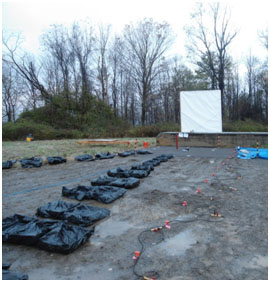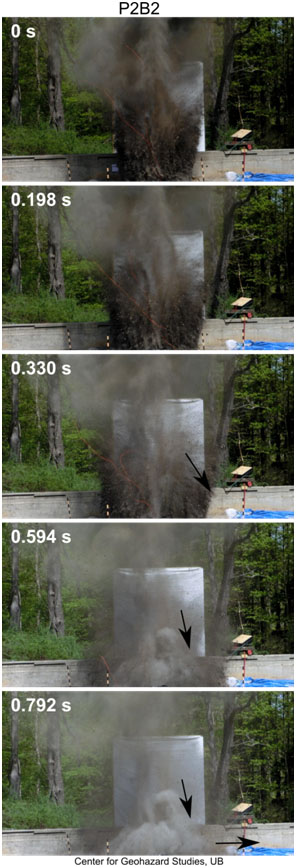IAVCEI Commission on Volcanogenic Sediments
►Scientific Report: Deposits in field-scale volcanic blast experiments
Alison Graettinger ahgraett@buffalo.edu
The study of maar-diatreme volcanoes is currently limited to either near surface deposits or eroded diatreme deposits. There are also very few historic eruptions of these volcanoes to compare with deposits. The need to better understand the relationship between volcanic process and deposits helped motivate the establishment of the Geohazards Field Station run by the University at Buffalo, New York. The goal of this facility is large scale experimentation to study geohazards, with a goal of international collaboration and long term facility development. So far this facility has been used to produce Man Made Maars. By using buried chemical explosives as an analog for subsurface explosions, the project has been investigating the links between subsurface and surface deposits, mixing in the diatreme, and the controls of jet shape on deposit distribution. Our large collaborative group includes members from five countries bringing a range of instrumentations and backgrounds.

Figure 1 Frame from high definition video of a subsurface blast experiment. The white surface marker is visible at the base of the jet. The core of the jet is darker reflecting the excavation of near surface layers made of limestone sand and gravels. Black garbage bags cover sample boxes used for every blast. (Image courtesy of the Center for Geohazard Studies).
A total of 31 blasts have produced 27 craters over two years have produced 100 kg of collected ejecta. The blasts take place in artificial strata composed of common aggregates in controlled layers. Previous experiments have been described in Valentine et al. (2012), Ross et al. (2013), and Taddeucci et al. (2013). Experiments in May 2013 focused on the relationship between subsurface strata and the deposits resulting from single and multiple subsurface blasts.

Figure 2 Experimental pad set up showing sample boxes, geophones and backdrop for high speed cameras. Neighboring blast locations (pad) are covered with tarps to highlight ejecta distribution.
The combination of high speed video and measured ejecta distributions provides important insight into the variety of deposits produced by discrete jets in volcanic eruptions. While the bulk of material falls back into the crater, large wide jets ejected material radially to produce broad ejecta rings, and fines-rich mobile flows. This collection of images below from a high definition video shows the behavior of larger clasts and fine particles as deposition begins. The time indicates the time relative to the first frame presented. Black arrows highlight the fine particles expelled laterally from the crater as the jet collapses. These experiments allow us to investigate the relationship between jet processes, blast energy, depth of explosion, and the effects of repeated blasts on a single crater system. One of the highlights of these experiments was the excavation of the artificial substrate after the blasts to observe the subsurface deformation and resulting structures. The combined dataset of subsurface pre- and post- explosion conditions with surficial deposits is one not offered by natural deposits. The integration of all these datasets is ongoing with interesting implications for maar-diatreme formation and deposit interpretation, ejecta dynamics, and the relationship between blast energy and deposit volumes / distribution.

Figure 3 Excavation of the pads after the experiment revealed the disruption in the subsurface by the explosions. This example had three co-located blasts well below the optimal depth of burial. The blue line indicates the level of disturbed pad material as determined through a manual compaction survey. The image on the right shows the benefit of these excavations where we can investigate the structures in three dimensions
These experiments will continue during the summer of 2014. If you happen to be attending AGU this fall 2013 you can get more detailed information on the facility, Maar experiments, and future plans there are four presentations in various sessions.
Monday pm Talk V14A-02: Taddeucci et al. Fake ballistics and real explosions: field-scale experiments on the ejection and emplacement of volcanic bombs during vent-clearing explosive activity.
Tuesday pm poster S23B-2495: Bowman et al. Precursory acoustic signals and ground deformation in volcanic explosions
Wednesday evening Talk V34C-05: Graettinger et al. Integrating processes and products of large scale cratering experiments
Thursday am poster V41D-2829: Sonder et al. Improving scaling methods to estimate eruption energies from volcanic crater structures using blast experiments.

